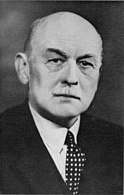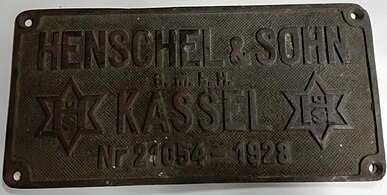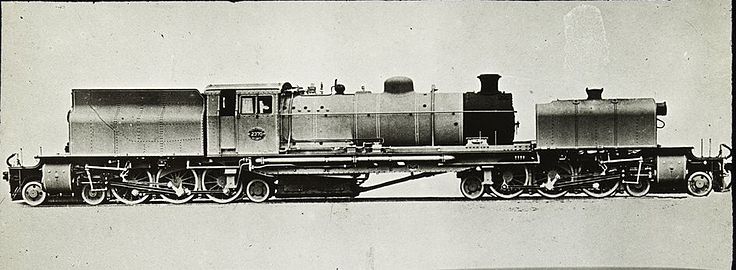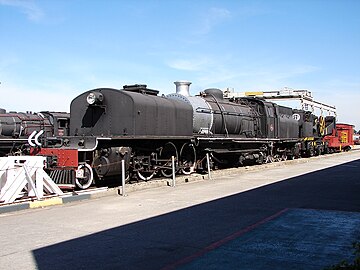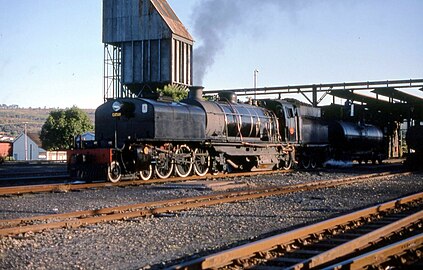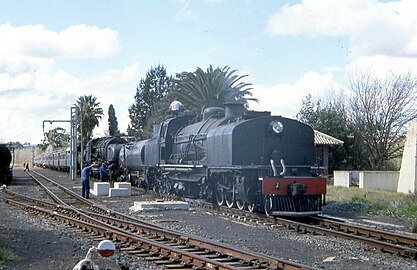South African Class GF 4-6-2+2-6-4
| South African Class GF 4-6-2+2-6-4 | |||||||||||||||||||||||||||||||||||||||||||||||||||||||||||||||||||||||||||||||||||||||||||||||||||||||||||||||
|---|---|---|---|---|---|---|---|---|---|---|---|---|---|---|---|---|---|---|---|---|---|---|---|---|---|---|---|---|---|---|---|---|---|---|---|---|---|---|---|---|---|---|---|---|---|---|---|---|---|---|---|---|---|---|---|---|---|---|---|---|---|---|---|---|---|---|---|---|---|---|---|---|---|---|---|---|---|---|---|---|---|---|---|---|---|---|---|---|---|---|---|---|---|---|---|---|---|---|---|---|---|---|---|---|---|---|---|---|---|---|---|
 No. 2427 at Mason's Mill, 6 July 1962 | |||||||||||||||||||||||||||||||||||||||||||||||||||||||||||||||||||||||||||||||||||||||||||||||||||||||||||||||
| |||||||||||||||||||||||||||||||||||||||||||||||||||||||||||||||||||||||||||||||||||||||||||||||||||||||||||||||
| |||||||||||||||||||||||||||||||||||||||||||||||||||||||||||||||||||||||||||||||||||||||||||||||||||||||||||||||
| |||||||||||||||||||||||||||||||||||||||||||||||||||||||||||||||||||||||||||||||||||||||||||||||||||||||||||||||
| |||||||||||||||||||||||||||||||||||||||||||||||||||||||||||||||||||||||||||||||||||||||||||||||||||||||||||||||
The South African Railways Class GF 4-6-2+2-6-4 of 1927 was an articulated steam locomotive.
In 1927, the South African Railways placed 37 Class GF Garratt steam locomotives with a 4-6-2+2-6-4 Double Pacific type wheel arrangement in service. A further 28 locomotives were delivered from two manufacturers in 1928.[1][2][3]
Manufacturers
[edit]During the term of office of Colonel F.R. Collins DSO as Chief Mechanical Engineer of the South African Railways (SAR) from 1922 to 1929, articulated locomotives were in great favour in South Africa, to the extent that the Railway Board of the day instructed that non-articulated engines should only be ordered in exceptional circumstances.[2]
The specifications for the Class GF 4-6-2+2-6-4 Garratt locomotive were prepared by Colonel Collins and an order for 37 locomotives was placed with Hannoversche Maschinenbau AG (Hanomag) in Germany. They were delivered in December 1927 and numbered in the range from 2370 to 2406.[1][2][3]
A second order for eighteen locomotives was placed with Henschel and Son in 1927. They were delivered in October 1928, numbered in the range from 2407 to 2424.[2][4][5][6][7][8]
This was followed by a third order, placed with Maffei in 1928, for a final batch of ten locomotives. They were delivered in November of that same year and numbered in the range from 2425 to 2434.[2][5][6]
-
Gf 2401
-
Col F.R. Collins DSO
-
Gf
Characteristics
[edit]The locomotives were superheated, had bar frames, piston valves and used Walschaerts valve gear. The Class GF was the only Double Pacific type Garratt to see service on the SAR and, until the arrival of the Class GMA, was the most numerous Garratt locomotive class in SAR service. It was designed as a mixed traffic locomotive for use on branch lines and secondary mainlines throughout the country.[2][3][6]
As built, the Class GF had inside bearings in their two-wheeled trailing trucks and considerable trouble was experienced with hot-boxes on these axles. Once these were modified to outside bearings, they proved to be very successful locomotives. Their good turn of speed and reasonably high tractive effort made the class a good utility locomotive.[1][2]
Cabside number plates
[edit]
From the establishment of the SAR in 1910, cabside engine number plates were inscribed "SOUTH AFRICAN RAILWAYS" in English only. This was still the case when the Class GF entered service, as seen on a Hanomag works picture of no. 2370. After the Official Languages of the Union Act No 8 of 1925 was passed on 8 May 1925, bilingual English and Afrikaans cabside number plates began to appear on locomotives, initially inscribed "SOUTH AFRICAN RAILWAYS" at the top and "SUID AFRIKANSE SPOORWEË" at the bottom, as shown. The Afrikaans spelling conventions were changed from time to time in the early years. On postage stamps, for example, it was "Zuid Afrika" from 1913, "Suidafrika" from the airmail stamps of 1925 and hyphenated "Suid-Afrika" from 1933. On cabside number plates, the Afrikaans inscription was later altered to "SUID AFRIKAANSE SPOORWEË" with the spelling of "AFRIKANSE" changed to "AFRIKAANSE", and still later to "SUID-AFRIKAANSE SPOORWEË" hyphenated.[9]
Service
[edit]South African Railways
[edit]The Class GF saw service on many lines in Natal, Transvaal, the Orange Free State and the Eastern Cape. In Eastern Transvaal, they were stationed at Nelspruit to work the branches to Graskop and Plaston. Along with the Class GE, some worked out of Johannesburg via Krugersdorp and Zeerust on the Mafeking line. Here, they were allowed to carry an increased coal load of 11 long tons 10 hundredweight (11.7 tonnes), compared to the 10 long tons (10.2 tonnes) which they were allowed on lighter rail elsewhere.[1][6][7][8][10]
The bulk of the Class GF fleet worked in Natal. They were used extensively on the Verulam and other North Coast local passenger services. Some were stationed at Empangeni to work the sugar cane traffic from Mtubatuba, while most were based at Mason's Mill to work the various branches which radiated from Pietermaritzburg. They worked a daily passenger train from Franklin to Kokstad, but on the other branches they were mainly used on goods and mixed train service.[1][6][11]
By June 1964, Greyville was still allocated nine Class GFs which were used mainly on local passenger and pick-up goods trains. Apart from four which were sold and two which were scrapped after collisions, the Class GF were all still in stock by 1972, although not all were still in operation. The last one in SAR service was scrapped in 1979.[3][6][12]
Mozambique
[edit]
Four of the Class GF, numbers 2370, 2419, 2420 and 2432, were sold to the Caminhos de Ferro de Moçambique where they were designated the Series 911, numbered in the range from 911 to 914.[1]
Industrial
[edit]Several of the Class GF locomotives were sold into mining service upon retirement. Most went to the Enyati Railway where, in later years, some were equipped with diesel-driven air brake equipment which was installed in a cage behind the coal bunker, since some of the SAR's air braked coal export block trains originated on the Enyati. As far as is known, the locomotives in industrial service were the following:[6]
- Numbers 2371, 2377, 2378, 2386. 2387, 2399, 2404, 2415, 2417, 2425 and 2429 went to the Enyati Railway of Enyati Collieries.
- No. 2433 went to Transvaal Navigation Collieries.
- One locomotive went to Tweefontein United Collieries and is believed to have later been transferred to Enyati.
Knuckle couplers
[edit]In 1927, the SAR began to convert the couplers of its Cape Gauge rolling stock from the Johnston link-and-pin coupling system which had been in use since the establishment of the Cape Government Railways in 1873, to AAR knuckle couplers. Judging from contemporary photographs as well as the official SAR Locomotive Diagram Book and the dimensional locomotive drawings as published by Holland, which were for the most part based on the original as-delivered and unmodified locomotives, the Class GF locomotives were delivered new with knuckle couplers fitted, as were the Classes 18, GCA, HF and U which also entered service in 1927.[1][7][8]

Conversion of all rolling stock would take several years and both coupler types could still be seen on rolling stock into the late 1950s. During the transition period, knuckle couplers on locomotives had a horizontal gap and a vertical hole in the knuckle itself to accommodate a link and a pin respectively. This enabled them to couple to vehicles which were still equipped with the older Johnston couplers.[1][7][8]
Knuckle couplers had first been used in South Africa more than two decades earlier. The Central South African Railways (CSAR) introduced Gould knuckle couplers on the rolling stock of its Limited Express and Imperial Mail passenger trains in 1904. The Limited Express operated between Pretoria and Johannesburg while the Imperial Mail operated between Pretoria and Cape Town. These knuckle-couplers also had split knuckles to accommodate coupling to the old Johnston couplers with a link and pin, since the CSAR retained the old couplers on all their locomotives to keep them compatible with their own goods and older passenger rolling stock as well as with that from the other railways it connected with.[13]
Preservation
[edit]Of the Class GF Garratts, three survived into preservation. By 2020 this was their status.
| Number | Works nmr | THF / Private | Leaselend / Owner | Current Location | Condition | |
|---|---|---|---|---|---|---|
| 2380 | THF | Umgeni Steam Railway | Masons Mill Locomotive Depot | Scrap | ||
| 2401 | THF | Transnet Heritage Foundation | Outiniqua Transport Museum | Preserved | ||
| 2416 | THF | Ingwe Municipality | Masons Mill Locomotive Depot | Scrap |
Illustration
[edit]-
Works picture of Hannoversche Maschinenbau AG-built no. 2370, the first of the Class GF with English-only cabside number plates, c. 1927
-
No. 2401 at the Outeniqua Transport Museum, George, 15 April 2013
-
Class GF no. 2401 between Swellendam and Bonnievale, c. 2001
-
Class GF no. 2401, here named Cathy, at Grahamstown depot, c. 1991
-
No. 2401 with a Class GMAM on the Union Limited, Buffeljagsrivier, c. 2001
References
[edit]- ^ a b c d e f g h Holland, D. F. (1972). Steam Locomotives of the South African Railways. Vol. 2: 1910-1955 (1st ed.). Newton Abbott, England: David & Charles. pp. 54–56. ISBN 978-0-7153-5427-8.
- ^ a b c d e f g Espitalier, T.J.; Day, W.A.J. (1946). The Locomotive in South Africa - A Brief History of Railway Development. Chapter VII - South African Railways (Continued). South African Railways and Harbours Magazine, January 1946. p. 13.
- ^ a b c d Paxton, Leith; Bourne, David (1985). Locomotives of the South African Railways (1st ed.). Cape Town: Struik. p. 92. ISBN 0869772112.
- ^ Henschel-Lieferliste (Henschel & Son works list), compiled by Dietmar Stresow
- ^ a b Hamilton, Gavin N., The Garratt Locomotive - Garratt Locomotives from Other Builders, retrieved 10 November 2012
- ^ a b c d e f g Durrant, AE (1989). Twilight of South African Steam (1st ed.). Newton Abbott: David & Charles. p. 113. ISBN 0715386387.
- ^ a b c d South African Railways & Harbours/Suid Afrikaanse Spoorweë en Hawens (15 Aug 1941). Locomotive Diagram Book/Lokomotiefdiagramboek, 3'6" Gauge/Spoorwydte. SAR/SAS Mechanical Department/Werktuigkundige Dept. Drawing Office/Tekenkantoor, Pretoria. p. 32.
- ^ a b c d South African Railways & Harbours/Suid Afrikaanse Spoorweë en Hawens (15 Aug 1941). Locomotive Diagram Book/Lokomotiefdiagramboek, 2'0" & 3'6" Gauge/Spoorwydte, Steam Locomotives/Stoomlokomotiewe. SAR/SAS Mechanical Department/Werktuigkundige Dept. Drawing Office/Tekenkantoor, Pretoria. p. 32.
- ^ Hefferman, Lutz (1997). The South African Stamp Colour Catalogue (21st ed.). Lutz Hefferman, P.O. Box 567, Johannesburg, 2000, R.S.A. pp. 37, 39, 45.
- ^ Soul of A Railway, System 7, Western Transvaal, based in Johannesburg, Part 24: Krugersdorp-Zeerust-Mafeking (Home Signal), Part 1 by Les Pivnic. Introduction: Engine Power.[permanent dead link] (Accessed on 5 May 2017)
- ^ Soul of A Railway, System 6, Part 1: Durban Old Station. Caption 44. Archived 24 October 2020 at the Wayback Machine (Accessed on 8 March 2017)
- ^ Soul of A Railway, System 6, Part 2: Greyville Loco, Greyville Station to Umgeni & Berea Road to Rossburgh. Caption 41. Archived 2 February 2017 at the Wayback Machine (Accessed on 26 November 2016)
- ^ Soul of A Railway, System 8, Part 1: Pretoria: including local services, workshops and running sheds, Part 1. Captions 8, 13. Archived 19 March 2017 at the Wayback Machine (Accessed on 15 March 2017)


